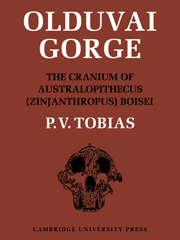Book contents
- Frontmatter
- Contents
- List of text-figures
- List of plates
- List of tables
- Introductory Note
- Foreword
- Editor's Note
- Acknowledgements
- I Introduction
- II Preservation and reconstruction of the cranium
- III The cranial vault
- IV The basis cranii externa
- V Certain critical angles and indices of the cranium
- VI The interior of the calvaria
- VII The thickness of the cranial bones
- VIII The endocranial cast of Zinjanthropus
- IX Metrical characters of the calvaria as a whole
- X The structure of the face
- XI The pneumatisation of the Zinjanthropus cranium
- XII The dental arcade and the palate
- XIII The pattern of dental attrition and occlusion, with comments on enamel hypoplasia
- XIV The size of individual teeth, absolute and relative
- XV The size of the dentition as a whole
- XVI The crown shape index of the teeth
- XVII The morphology of the teeth
- XVIII Summary of cranial and dental features of Zinjanthropus
- XIX The taxonomic status of Zinjanthropus and of the australopithecines in general
- XX The cultural and phylogenetic status of Australopithecus boisei and of the australopithecines in general
- References
- Index of persons
- Index of subjects
- Plate section
IX - Metrical characters of the calvaria as a whole
Published online by Cambridge University Press: 05 November 2011
- Frontmatter
- Contents
- List of text-figures
- List of plates
- List of tables
- Introductory Note
- Foreword
- Editor's Note
- Acknowledgements
- I Introduction
- II Preservation and reconstruction of the cranium
- III The cranial vault
- IV The basis cranii externa
- V Certain critical angles and indices of the cranium
- VI The interior of the calvaria
- VII The thickness of the cranial bones
- VIII The endocranial cast of Zinjanthropus
- IX Metrical characters of the calvaria as a whole
- X The structure of the face
- XI The pneumatisation of the Zinjanthropus cranium
- XII The dental arcade and the palate
- XIII The pattern of dental attrition and occlusion, with comments on enamel hypoplasia
- XIV The size of individual teeth, absolute and relative
- XV The size of the dentition as a whole
- XVI The crown shape index of the teeth
- XVII The morphology of the teeth
- XVIII Summary of cranial and dental features of Zinjanthropus
- XIX The taxonomic status of Zinjanthropus and of the australopithecines in general
- XX The cultural and phylogenetic status of Australopithecus boisei and of the australopithecines in general
- References
- Index of persons
- Index of subjects
- Plate section
Summary
In Table 18 are recorded a number of measurements of the Zinjanthropus cranium, especially metrical characters which have not been dealt with in the preceding sections. Most of these measurements relate to the calvaria alone, but several—such as nasion–basion length and basion–prosthion length—are, strictly speaking, cranial rather than calvarial measurements. To compare with the Zinjanthropus data, I have assembled as many measurements on the South African australopithecines as could be culled from Broom et al. (1950), Broom and Robinson (1952), Dart (1962b) or obtained by personal measurement; as well as some comparable measurements on Homo erectus.
Considerable difficulties arise when one attempts to apply measurements devised and defined for the description of modern human crania to ancient hominids, as well as to non-hominid Primates. These problems have been fully discussed by Davidson Black (1931), Washburn (1942) and Weidenreich (1943) among others. Among the most difficult termini of measurements are inion and euryon.
Cranial length and the toro-occipital index
In modern hominine crania, the inion and the opisthocranion (furthest occipital point) are different points, the former low and the latter high on the cranium. On the other hand, in some Neandertal crania, in H. erectus, in the australopithecines and in many pongid crania, the two points coincide to mark the posterior terminus of the maximum cranial length (glabella–opisthocranion).
- Type
- Chapter
- Information
- Olduvai Gorge , pp. 95 - 103Publisher: Cambridge University PressPrint publication year: 1967

